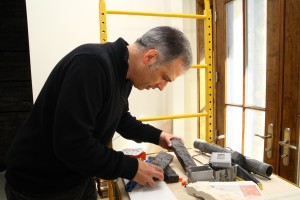When Westport architect Robert M. Berger started his design-build firm in 1993, the Fairfield County market was robust with homeowners interested in custom-designed additions. He developed a waiting list that could fill an entire year with work.
Nowadays, Berger has drastically scaled down on the number of projects, but each is worth millions of dollars.
Size, he said, is not the biggest factor in creating luxury; rather, it”™s about creating a sensory experience.
Berger”™s most recent project, a French-influenced luxury home in Westport, has taken two years to build from the ground up.
Berger is involved in all components of this custom-built home from the idea of building out a foundation that creates four courtyards to shaping the interior walls of the grand foyer and dining room with an eye to comfort.
When it comes to building and designing a home, Berger believes it”™s not good to have too many cooks in one kitchen. In his firm, he hired five employees to help draft, but he”™s the one who shows up at each client”™s doorstep and discusses everything from blueprints to building materials to sound and lighting. From sketching and designing to buying and building, he does it all.
“I”™m laying out the entire house for the homeowner,” Berger said. “I”™m going over all of their individual needs on a very personal level ”” all their likes and dislikes, colors, brightness levels, their interactions with their families, how often they entertain and the idiosyncrasies of their own personal taste.”
Berger specializes in cross applications, where he repurposes the function of a material to serve another role. For his current project, Berger suggested the idea of building out a wine room, whereby the wall would be constructed using dyed limestone with speckles of mica chips to add luster. The wine bottles would then be suspended by metal rods that Berger would shape into jigs and screw them into the veneer stone wall. The cost would be significantly reduced through Berger”™s strategy of repurposing.
“Most architects will have a disconnect from that aspect because they”™re not pricing out individual components,” Berger said. “But I”™m in the stone yards and tile shops, and it”™s me personally doing it, so I know how much those things are going to be.”
Adding to the element of luxury for his clients”™ home, Berger built out a laundry drop-off door hidden inside a stone panel in the main entryway and a garbage drop off by the garage. In addition, each garage port will have a small table at the entry and hallway closets for the homeowners to drop off their keys and jackets before entering the kitchen, living room or dining space.
When it comes to the mechanics of the home, Berger said he pays attention to details that will make a home more energy efficient and durable. He explains to homeowners how they can save up to 50 percent on their energy bills by building out geothermal units instead of conventional heating and air conditioning systems and installing more durable insulation materials.
“You can save 50 percent on fossil fuels by using geothermal and we”™ve been doing geothermal for 20 years,” Berger said. “From a mechanical standpoint, a spec home builder will have two units to handle the whole house. The builder can buy a dirt cheap unit and not have a homeowner say, ”˜I don”™t want that.”™ But when it”™s a custom home, owners want the best of everything.”
In Berger”™s view, what makes a home luxurious is different from what people conventionally think of. He said it”™s not about how spacious a home is or how much it costs to build it out, but it”™s about having heightened sensory experiences within the space.
“It”™s all about the extra sensory perception you”™re feeling within the space,” Berger said. “I think the rest of the world perceives luxury homes as being larger and made of more expensive materials, but that”™s not how I define it. Each room is an experience. Luxury also means having functional elements that normal homes might not have. Part of the experience is having music and lighting.”
In the living room, the windows all have automatic curtains that drop down when the sun sets. A remote control that can be accessed through a smartphone or tablet can operate the shades, the television and the radio at the same time. The idea of having centralized mechanics is to create a luxury experience that embeds technology into everyday functional living.
As Berger looks back on the challenges of starting his own business, he said the reason his firm stayed afloat, especially during the recession when the demand for home additions dried up, was by marketing diversified services and wearing multiple hats as an architect, builder and decorator.
“I”™ve always pursued being the master architect the way Frank Lloyd Wright was,” Berger said. “I did everything and I was a little bit less fee-wise. That allowed homeowners to concentrate on making money, and they only have to deal with one person – Rob Berger ”” not an army of people. Through the recession, people liked that I could help them control costs on all aspects.”
Berger, whose business has expanded into New York”™s tony Hamptons, New Jersey, Manhattan and even California, said he plans to run a tight operation and invest in a few long-term residential projects at a time.



















